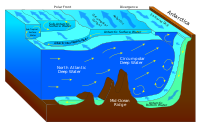
Photo from wikipedia
Antarctic Bottom Water (AABW) is the coldest, densest, most prolific water mass in the global ocean. AABW forms at several distinct regions along the Antarctic coast and feeds into the… Click to show full abstract
Antarctic Bottom Water (AABW) is the coldest, densest, most prolific water mass in the global ocean. AABW forms at several distinct regions along the Antarctic coast and feeds into the bottom limb of the meridional overturning circulation, filling most of the global deep ocean. AABW has warmed, freshened, and declined in volume around the globe in recent decades, which has implications for the global heat and sea level rise budgets. Over the past three decades, the use of tracers, especially time-varying tracers such as chlorofluorocarbons, has been essential to our understanding of the formation, circulation, and variability of AABW. Here, we review three decades of temperature, salinity, and tracer data and analysis that have led to our current knowledge of AABW and how the southern component of deep-ocean ventilation is changing with time.
Journal Title: Annual review of marine science
Year Published: 2018
Link to full text (if available)
Share on Social Media: Sign Up to like & get
recommendations!